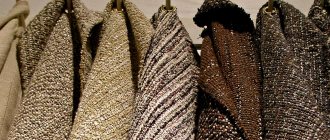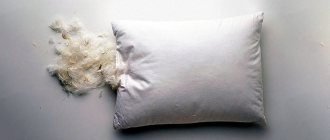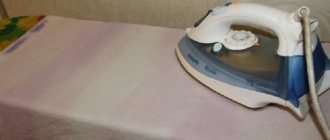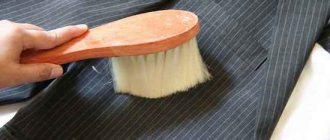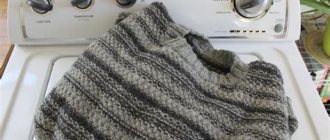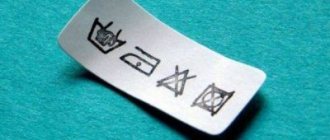Capricious material
Perhaps you have encountered a situation where you put a normal men's sweater in the washing machine, and take out something that would hardly fit on a child. It's all about the wrong temperature and the rapid rotation of the drum. These two factors cause the structure of the tissue to change slightly, and it shrinks, decreasing in size.
Being a natural material, wool is very sensitive to water temperature. If there is no obvious contamination, then it is better not to wash woolen items at all. Just periodically take them out of the closet and ventilate them to minimize contact with water. But when traces of dirt appear, the thought inevitably arises: how to wash woolen items? In this case, we recommend that you listen to our advice.
- Turn your clothes inside out before you wash them.
- Use synthetic liquids to wash wool. They dissolve quickly and rinse well.
- Select the “wool” mode in your washing machine to prevent your clothes from shrinking. If you have never used this mode before, check whether it corresponds to low temperature, slow drum rotation and low spin.
The condition of your things will directly depend on which mode you choose. If you mistakenly turn on the wash at 60°, and even put on a strong spin, then you can say goodbye to your favorite jacket (dress, sweater, hat) forever.
How and what items to dry in the dryer: what items should not be dried in the dryer after washing?
You should absolutely not tumble dry:
- Items made from very thin fabrics (tulle, cambric)
- Nylon
- Lace underwear
- Knitted items
- Clothes with embroidery and appliqués
- And also with metal decorations or details
- Products that dry unevenly. For example, pillows, down jackets
Important: It is worth considering the model and brand of the dryer, since each has its own set of programs. Some dryers have features for drying feather items. And some machines allow a combination of programs, for example, extra drying and “warm air blowing”. And still others can completely ruin the down jacket.
The key to proper drying is choosing a program!
How to dry things in the dryer:
- You need to sort by type of fabric, because each type has its own program
- All buttons and hooks must be fastened and laces tied
- To prevent small items from getting inside the duvet cover or pillowcase, it is worth sewing up the holes during washing.
- Remove all foreign objects that could damage things or mechanically damage the drum if exposed to strong heat.
- Choosing a program is the key to quality drying. The most popular functions are “iron” (clothes will be slightly damp) or “closet” (clothes can be put on immediately)
- Extra or super dry is not suitable for cotton or linen. Things can shrink in the first case and become very hard in the second. These programs are for coarse and multi-layered fabrics
- If you need to ventilate your clothes and give them freshness, turn on “cold air”
- Despite the general sorting of things (for example, cotton, synthetics or jeans, shirts), check whether this type really belongs to this group. The classification may be slightly different for different manufacturers, if there is a complete set of programs
- Do not leave items in the car long after the cycle has ended. They may become dry
- After use, always pour out the accumulated condensate in a special container (if a hose is provided to drain it, this step can be skipped)
- Before drying again, the machine must rest for at least 30 minutes.
- And don't forget to clean the filters regularly!
Cleaning the filter
Turn over periodically
Don't wait for the sweater to dry on its own. Otherwise, one side will dry faster, while the other will remain wet. Be sure to turn the product a couple of times a day to avoid uneven drying.
Having mastered these secrets, you will learn how to dry knitted items correctly and not ruin their shape. And then your favorite sweaters and cardigans will remain beautiful and last for a very long time.
- Author: iarriba
Rate this article:
- 5
- 4
- 3
- 2
- 1
(2 votes, average: 2 out of 5)
Share with your friends!
Ironing tips
Properly dried woolen items rarely need to be ironed. If necessary, set the heat regulator on the iron to the “wool” position. The dry item is placed on the ironing board. Iron without steam through damp gauze with careful, pressing movements.
Ironing is successfully replaced by steaming. When using the iron with steam, it should not touch the surface. The ideal option would be a steam generator.
You can straighten out creases and wrinkles on woolen items without the help of household appliances. All you need to do is hang your clothes on hangers and place them in a steamy bathroom. Sometimes simple moistening with water from a spray bottle helps.
Under the influence of moisture, the surface will straighten and take its original shape. In a room with hot steam, odors of smoke, sweat, and food are also successfully removed.
How to get rid of pellets
Woolen clothing is prone to pilling when worn. There are several ways to remove them.
- Use a plastic, fine-toothed comb. You need to carefully comb the canvas from top to bottom. This is what they do with fluffy clothes made of wool and angora.
- Shaving with a disposable razor. Movements should be light, without pressure, so as not to cut the threads. A prerequisite is to take a used razor, not new and not completely dull. The method is used on a smooth, fluff-free surface.
- A special machine for removing pellets is a simple and effective way. Purchasing a machine will make caring for wool items easier for several years.
- If the fibers of wool on the fabric roll down, then you need to go over them with a medium-hard toothbrush.
More methods for getting rid of pellets.
Some care tips
- Dirt stains from wool fabric can be easily removed with a brush after drying.
- Soaking in cool water with lemon slices will help restore the whiteness of yellowed wool.
- It is recommended to rinse woolen items with the addition of wine vinegar (1 tbsp per 10 liters of water).
- Shiny areas should be ironed through a cloth soaked in water with a little vinegar added.
Hand washing a sweater
The right solution to restore the cleanliness and freshness of a knitted wool sweater is to wash it by hand. But even this method does not guarantee safety. In order not to spoil it, you need to follow simple recommendations:
- Wool sweaters should not be pre-soaked.
- Cleaning occurs from the wrong side.
- It is forbidden to twist it. Excess water should be lightly squeezed out and the item placed on a terry towel to absorb, which is changed as it gets wet.
- Further drying takes place only in a horizontal position.
Do not pour or pour cleaning products directly onto clothing. Before immersing the sweater, thoroughly stir the substance in water until completely dissolved and foam forms.
Grease stains on wool are removed with mustard. To do this, mustard powder is diluted in a small amount of water until a liquid mushy mass is obtained. The substance is placed in gauze and the flowing liquid is squeezed into water, which is changed several times, repeating the steps with mustard. Ammonia must be added to the rinse water. A teaspoon of the substance is enough for 10 liters.
How to dry things in a house or apartment: reviews
Stanislava, 38 years old, Jurmala
I understand perfectly well that constantly drying things in an apartment is harmful to health. But there is no way out if you live in a multi-story building. And on the balcony, washing in wet weather can take a very long time to dry. Of course, I try to minimize drying in the room, but if it cannot be avoided, then I ventilate it as often as possible. Now I use a dehumidifier. Still, the health of relatives is more important.
Yulia, 23 years old, Saratov
As a young mother, I am very worried about having a normal microclimate in the house. But with small children, the laundry is almost never finished. We have to cover both radiators and heaters. But this is probably the reason for the formation of mold on the windows. Vinegar has truly become a salvation - it not only disinfects, but also significantly reduces the formation of spores.
Maria, 43 years old, Kurgan
I've been drying things in my apartment my entire life. Of course, in a private home, outdoor drying is a big plus. But so far everyone is alive and the children have grown up healthy. I think it’s not only about the humidity of the room, but also about proper nutrition for a healthy immune system. Although I can’t help but agree that high humidity is a disaster. I save myself with the oven, and heaters, and radiators. Still, things dry faster with them!
Washing a sweater in a machine
Can wool be washed in a machine? The machine will help if there is not enough time for manual cleaning or if this method failed to achieve the desired result. In this case, you will need not only detergent, but also conditioner or rinse aid. You should not load a wool sweater along with other wardrobe items. The most important point is choosing the right mode.
The machine washing process carries a risk to the integrity of the wool fibres. The result may be a smaller item.
Sequencing:
- Purchase special products for cleaning wool fabrics.
- Place the sweater inside a special bag for washing machines.
- Fill the corresponding compartments with detergent and conditioner.
- Select the correct mode.
- Turn off the spin function. Even at minimum speeds, damage to delicate fibers occurs.
- Upon completion of the process, do not remove the sweater immediately. It is better to wait until the excess water drains itself.
Modern devices are equipped with a function for woolen materials. Otherwise, manual or delicate mode will do. In this way, it will be possible to ensure the preservation of the appearance and shape. It is imperative that in any of the selected modes the water temperature is no higher than 30°C.
To prevent the product from expanding, the machine wash time should be less than 40 minutes. Long and frequent water procedures using technology deteriorate the appearance and quality of the material.
Woolen clothes prefer to be washed by hand. Washing machines are used only in cases of extreme necessity.
Storage recommendations
In the summer, clean and ironed wool clothes should be carefully stored in a closet or put in cardboard boxes, taking care to protect them from moths. You should not hang woolen sweaters on hangers to prevent them from stretching out.
For pleasant aromatization and protection from moths, sachets with lavender or chestnuts should be placed on the shelves. Special tablets and strips soaked in lavender oil are effective.
Choice of product
If you need to wash woolen products, the question becomes, what kind of powder can you use?
When choosing a detergent, you need to pay attention to the following series of requirements:
- the packaging of the detergent must indicate that it is intended for woolen products and does not contain alkali;
- the composition should not include various enzymes and bleaches;
- If possible, the choice should be made in favor of liquid detergent rather than powder. Powders contain many substances that impart hardness. Liquid, gel-like products are washed out well, have minimal impact on the material and remove dirt just as well as powders;
- the use of a stain remover is acceptable if it states that it is suitable for delicate fabrics;
- You can wash a mohair jumper using simple shampoo.
Drying tips
You cannot dry woolen items in a vertical position, hanging on a rope, because they will stretch and lose their appearance. You shouldn't use clothespins either - they leave marks. Knitted clothes are dried laid out horizontally in a carefully straightened form. There is no need to stretch the product.
You should allocate a place for drying on the table or floor and cover it with a piece of thick film. Place a thick towel and a woolen product on top. Exposure to sunlight and thermal air from heating sources should be avoided. When pulled over pillows or bolsters, the shape of things is distorted.
Interesting fact! Animal hair, which is used to make woolen items, is similar to human hair. Therefore, care for wool products can be carried out with hair washing preparations. Clothes will become much softer and more tender after rinsing with the addition of hair conditioner, which is easy to verify.
Is it possible and how to dry things on an oil heater?
An oil heater is popular among many residents for additional heating of an apartment or house. And the first thing you need to understand is that it is not intended to dry things on it!
Why you shouldn't use it as a clothes dryer:
- Wet things, as in the case of a heating radiator, prevent radiated heat from escaping into the room
- Things get very dry on the heater
- If you cover the grill through which air escapes, you can cause the heating element to overheat. And this will lead to damage to the device itself.
- If the radiator shut-off sensors are broken, then do not clutter it with wet clothes
- But due to the triggering of sensors, drying clothes may not be as effective. After all, the device turns off for cooling on average after about 20 minutes.
But this is still a solution for those cases when you urgently need to dry certain clothes. After all, batteries do not heat up as much as heaters. Even taking into account the periodic shutdown of the device for cooling, things on the heater will dry many times faster.
It is important not to block air circulation
The main advantage of drying things on an oil heater: The heaters themselves, in principle, greatly dry out the air. Therefore, it is worth placing a container of water or a damp towel on it or nearby. And if you dry things on a heater, the humidity in the room will normalize itself!
Advice: Taking into account technical and fire safety, it would be rational to use a special dryer, which is mounted on top of the radiator. On it, things will dry quickly from the heat of the heater, without blocking the normal air circulation.
When drying things on a heater, you should follow some rules:
- Use only a serviceable and intact heater, without traces of rust.
- To avoid causing corrosion, do not hang items immediately after washing.
- Never cover the air circulation grille!
Important: But don’t be scared – oil heaters don’t explode! In the event of a breakdown, the heating element may burn out or hot oil may leak.
Device
